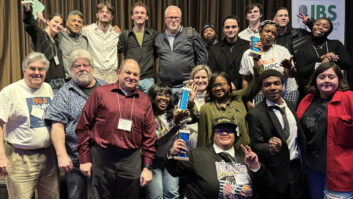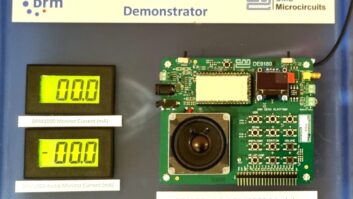DELTA JUNCTION, Alaska
It’s just one test of the Digital Radio Mondiale technology, in one very big state. But could the results lead to a new kind of regional radio service in which U.S. broadcasters could use shortwave to reach listeners within the United States?
It’s too soon to tell. However the filing of an application for an experimental license here to transmit a digital radio signal on three shortwave channels using DRM technology, potentially funded by the Defense Department, has raised the curiosity of some observers.
The president of Digital Aurora Radio Technologies has asked the FCC to approve a two-year experimental authorization to test statewide transmission of DRM in the 5, 7 and 9 MHz shortwave bands.
(click thumbnail)An antenna placement graphic from Digital Aurora Radio Technologies.In its FCC application, Digital Aurora states: “Pending this [FCC] authorization and funding availability, initial tests will likely be tasked and funded by the U.S. Government Department of Defense, Joint Electromagnetic Technologies Program.”
Details of that program are said to be classified. An unclassified 2002 budget document posted on the Web site www.js.mil said the JET Program “supports the Defense Community in general with a particular emphasis on the requirements of Special Forces and Intelligence in their Weapons of Mass Destruction (WMD), Deep Underground (DUG) and Transnational Threat (TNT) missions. This is in the form of basic research and applied RDT&E in HF/VLF/ELF communications and signaling, advanced forms of optical communications, underground imaging and advancing our understanding of the propagation of all forms of RF communication.”
DRM is an open standard, designed for the digitization of the frequencies below 30 MHz: long-, medium- and shortwave. It’s used mostly on shortwave frequencies in European and other countries.
An extension called DRM+ is in the works. The DRM Consortium — comprising broadcasters, associations, network operators, manufacturers, research institutions, regulatory bodies and others — plans to expand the system to broadcasting bands up to 120 MHz.
Application pending
On its application, the company said the goal is to assess performance of digital terrestrial shortwave broadcasting and serve the entire state.
“In general, the population of Alaska is underserved with respect to the ability to have a high-quality, reliable public radio audio service,” the company wrote. “This is especially true for sparsely populated areas of the state,” though that statement discounts public stations, which cover much of Alaska.
Company President Whit Hicks declined comment for this story, saying he did not want to “presume” FCC approval. An Internet search turned up no prior information on the company, which submitted the application in late April. The application remained pending in June.
A source close to the issue said the request was not controversial and that approval of the experimental license could come this summer.
That timeframe is key to Digital Aurora, because many of the submitted measurements regarding sunspots could change as the year goes on. Also, the company needs to build an antenna in Alaska, where severe weather allows a short time-period for construction and accessing the site.
It plans to construct a crossed dipole antenna with an overall height above ground of 20 meters, roughly 66 feet.
According to the application, the DoD-funded test would use existing 100 kW Continental transmitters designed for an Over-the-Horizon radar transmitting system formerly used in Cold War broadcasting and a digital signal generator operating from the Delta Junction area, some 130 miles southeast of Fairbanks. Other than that, the DoD connection is unclear.
One transmitter producing output average power of 20 kW, in concert with an antenna that sends most of its radiated power into Alaska, should be able to be received throughout the state, the company believes.
However, Digital Aurora needs to determine if such reception can be accomplished during times of high and low solar activity.
DRM has been tested extensively in latitudes lower than those that include Alaska. This experiment, the company said, will help to fill a gap in assessing the performance of digital terrestrial shortwave broadcasting in a difficult high-latitude environment.
Antenna spec
The company hopes also to determine what transmission power levels will produce a reliable signal that can be received on DRM radios. Digital Aurora also hopes to determine an antenna specification to deliver a signal statewide.
Digital Aurora proposes to perform propagation, signal-to-noise ratio, field strength, bit rate and audio quality measurements over a two-year period, according to the application.
“Compared to an ordinary analog shortwave signal, the DRM signal can operate with the same coverage reliably … in a 10 kHz channel using a transmitter power level approximately one-fifth of that needed for the analog signal,” states Digital Aurora in the application. The FCC assigned call sign WE2XRH.
DRM is designed to fit in with the existing AM broadcast band plan, based on signals of 9 kHz or10 kHz bandwidth, according to the Web site www.drm.org. It also has modes requiring only 4.5 kHz or 5 kHz bandwidth, and modes that can take advantage of wider bandwidths, 18 kHz or 20 kHz.
The cost of the test was not listed on the application, which stated that utilities and space would be leased and the existing government-provided transmitters left in place when the experiment ends.
Digital Aurora believes it can contain most of the signal within Alaska with little spillover into Canada. To avoid causing interference it plans to stay at least two adjacent channels away from any channels used by international broadcasters into western Canada.
The two-year test proposal appears notable because it would be the first time DRM has been tested in the United States at such high latitudes, and because the company is proposing to broadcast using digital shortwave technology to an entire state.
Without knowing more about Digital Aurora’s intentions, it’s hard to know the practical implications of the test, observers said.
While engineering observers laud DRM technically, they said it’s hard to make a practical business case for DRM on shortwave in this country, noting that several countries are abandoning shortwave and turning to less expensive programming distribution platforms such as the Internet and FM.
“What new audience that isn’t presently served will be covered and at what cost per person?” asked one observer.
Several sources raised the issue of DRM receiver availability. Indeed, in a separate paper presented at the NAB Show on standards and codecs for digital radio in Europe, Fraunhofer’s Olaf Korte states that Digital Radio Mondiale still lacks affordable mass-market receivers. He added that the use of DRM in mass markets like Russia and China would help to solve that issue.
In this country, shortwave broadcasters are restricted from transmitting to listeners within the United States. It would be interesting to see if successful results make the case to change that rule, one observer noted, because such a service could help “under radioed” populations, like Alaska.
And going even further, could successful results lead one day to testing DRM on the AM band here, considered by some to be a logical choice to challenge IBOC?
Sources said no, that circumstances surrounding this test are so unique they don’t support that extrapolation.













